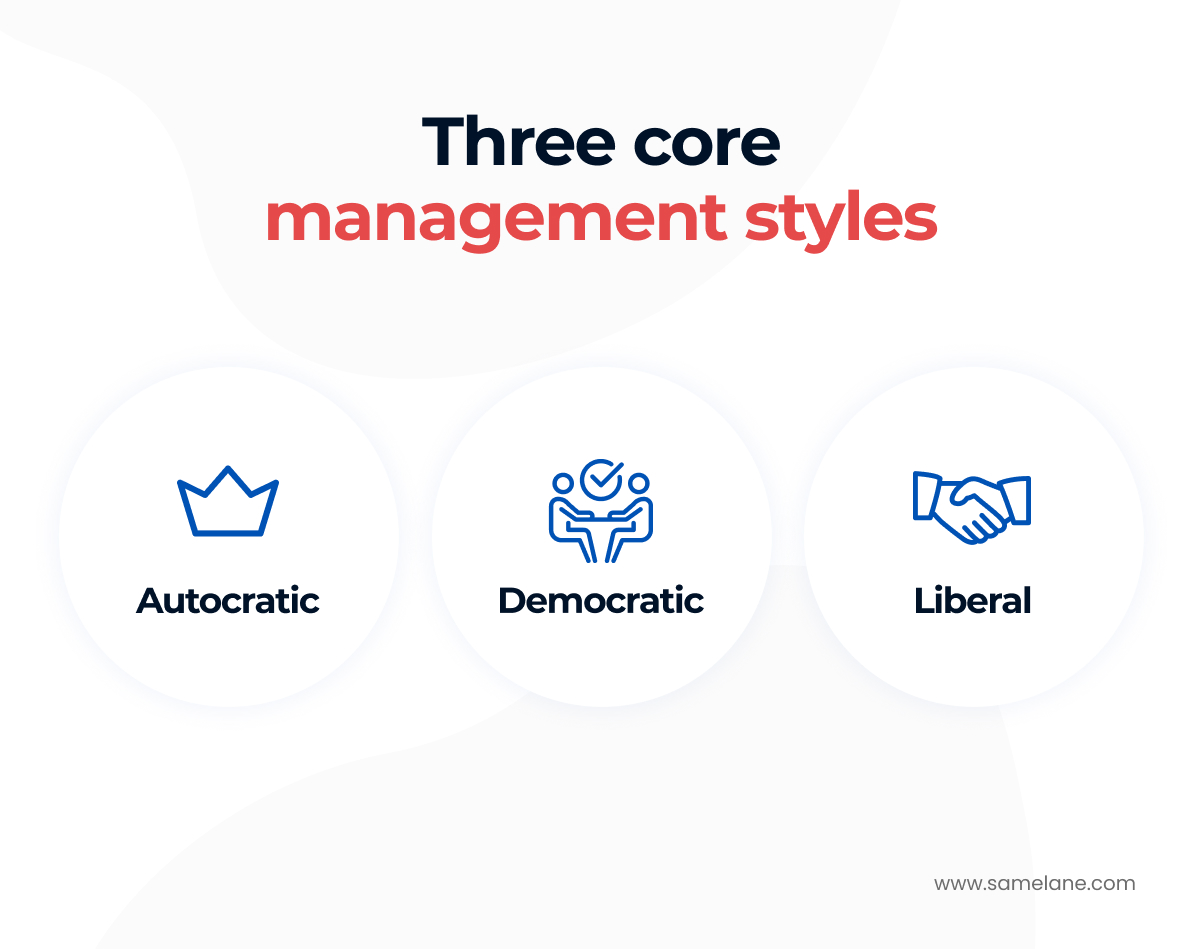There may be as many management styles as there are ideas for running a business. Everyone has got one of their own. Unique as they may seem, it is possible to see a pattern within the styles and discern certain types of management based on their most distinguishable features.
Although management techniques are usually organization-specific, ultimately, they all come down to how the message is communicated. Depending on the goals and team structure, a manager can adopt a suitable approach, which only proves that management style is a flexible tool and should be adjusted to the circumstances. At the end of the day, the way you manage your team is the main driver for your joint success.
What is a management style?
This article will discuss three primary management style types and their derived sub-types. The most general and commonly used styles include autocratic, democratic, and laissez-faire approaches. The proposed typology is pretty generic, but it provides a clear framework for expanding further, more specific types of management. But before we get to each of them, let’s start from the bottom. What exactly is a management style, and how do you define it?
Management style: The definition
A management style is how managers approach their role and interact with their team to achieve goals. It is based on factors like management level and type of organization strengthened by the manager’s will to accomplish objectives.
While managers have some control over how they exercise their authority, their dominant character traits also play a significant role. By understanding their leadership and communication styles, managers can develop specific skills to better adapt to their team’s needs and maximize motivation.
Management style encompasses several aspects, including:
- Decision-making: How the manager makes choices, whether independently, with some input, or collaboratively with the team.
- Planning and organization: How the manager sets goals, assigns tasks, and structures the workflow.
- Communication: How the manager communicates expectations, feedback, and information to the team.
- Delegation: How much authority and responsibility the manager gives their team members.
- Leadership: How the manager motivates, inspires, and guides the team towards achieving objectives.
The three core types of management styles
While countless business guides and case studies explore management techniques, three core leadership styles form the foundation: autocratic, democratic, and laissez-faire. We’ll delve into each style, defining its characteristics and ideal application. Remember, effective management is an adaptable art. Understanding these styles allows you to tailor your approach to maximize success within different team dynamics and situations.

Autocratic management style
It is probably the most familiar one, as it does not require great skills or knowledge of effective communication, just a strong personality. This style is characterized by a high level of control from the manager. They make decisions unilaterally, provide little explanation or opportunity for input, and expect employees to follow instructions closely. The decisions are based on the manager’s judgment and beliefs, while the knowledge and expertise of the team members are pushed into the background. It is the most controlling way of managing, where, like in the Panopticon, every subordinate is micromanaged by consistent supervision.
While the autocratic leadership style may seem outdated in today’s market, where employee autonomy is valued, it can still work remarkably well when decisions must be made quickly and firmly, such as in times of crisis and change. This management style also works in hierarchical organizations, where the decisions are made on a higher level and communicated top-down to the employees with no place for discussion.
Drawbacks of autocratic management style:
It’s essential to be aware that this style can stifle creativity, demotivate employees, and hinder their problem-solving abilities. It does not encourage their development either. Being a downward spiral for ambitious professionals, this type of leadership is appreciated by the non-autonomous staff members who need clearly defined tasks and find supervision the only motivating factor.
Subtype 1: Authoritative management style
At some point, a more informed autocratic manager might want to turn the tables a bit and start acting as a respectful authority. However, when the authoritative management style is performed with solid skills, it can be really effective. While an autocratic leader demands and expects compliance, the authoritative manager will encourage the team to act towards the common goal thanks to a position of confidence and emotional intelligence. So, business authorities provide direction and vision to their team members instead of forcing their way.
Subtype 2: Persuasive/patronizing management style
The persuasive or patronizing style is another management approach rooted in the autocratic modus operandi. It largely overlaps with the authoritarian style but involves the team more. A persuasive manager is still in control of every business decision; however, more inviting toward the subordinates’ questions. A leader using this style can be seen as a father figure, patronizing but still able to convince the employees that the decisions made are in the team’s best interest. Despite the manipulative character of this style, a persuasive manager can establish a certain level of trust, as all decisions taken serve the common good. The method proves effective when managing large teams of low-skilled employees who appreciate being taken care of.
Subtype 3: Exploitative management style
Exploitative management is the last and least compelling style we decided to mention when discussing the methods derived from autocratic thinking. This kind of leadership preys on the team’s work for the manager’s self-interest. It usually involves exploitation based on egoistic motivation, manipulation, or taking credit for coworkers’ efforts. It is hard to imagine an example where this management approach could work and bring positive results.
Democratic management style
Democratic management involves team members in decision-making processes. This style characterizes executives who actively involve team members and seek their input when making decisions.
The participative nature of the democratic style encourages the exchange of ideas and strengthens communication between the management and the team. Being a part of the decision-making process is an actual team-building experience that visibly enhances the employees’ work engagement and fosters a positive work environment. While the team’s feedback is valued and considered, at the end of the day, the full accountability for the decisions lies with the manager.
Drawbacks of democratic management style:
Apart from the apparent benefits the democratic style brings, it is not free from some drawbacks. This method requires time to work its way, as decision-making turns into a process, and reaching consensus takes longer than a top-down approach. This style may not be suitable for situations requiring quick decisions or where the team lacks the necessary knowledge or experience. Additionally, the democratic style demands strong leadership skills in facilitating discussions and managing conflict.
Subtype 1: Consultative/participative management style
The consultative or else participative style sits somewhere between democratic and autocratic styles. It shares characteristics of both, emphasizing seeking input before making decisions. Keeping the authority, the leader involves their employees in making decisions, building their confidence and mutual trust. This approach makes people feel their opinion is essential, significantly impacting their work motivation.
While valuing their team’s input, the manager ultimately retains the authority to make the final decision. However, they explain the rationale behind the decision, even if it doesn’t align perfectly with every suggestion.
Managers who are open to feedback and opinions of their experienced team members are more likely to make informed strategic decisions. The consultative way of managing might distress those team members who would instead not get involved in decision-making at all.
Subtype 2: Transformational leadership
Going further into the more advanced levels of management, we come across the transformational leadership model. This style focuses on inspiring and motivating employees to achieve their full potential and strive for something beyond just meeting basic job requirements. The leader plays the role of a tutor, helping the team grow while giving them autonomy over assigned tasks and a strong sense of ownership of the task.
The success of this style heavily depends on the charisma and effectiveness of the leader, so it is reserved for more experienced managers and above-mid-level employees.
Laissez-faire management style
Managing in a laissez-faire style means as much as letting people do as they choose. It might sound shocking to those used to the traditional working culture with the manager as a central figure. However, this approach has far-reaching effects when applied to a team of highly skilled specialists who are oriented toward the objectives.
Working within the laissez-faire framework requires great trust and little management. No micromanagement or interference from the leader is involved. This way of working will likely succeed when working with highly skilled professionals driven by intrinsic motivation, without supervision to achieve objectives. It is most suitable for creative professions where the given autonomy works in favor of innovation. The laissez-faire attitude also applies to the SCRUM methodology, where tasks get self-assigned.
Drawbacks of laissez-faire management style:
As with each of the previously mentioned styles, laissez-faire style also has some drawbacks. Without clear supervision, employees may struggle to understand tasks or priorities, which leads to increased errors. With minimal manager feedback, they may also miss opportunities to learn and improve.
Subtype 1: Delegative management style
The delegating style is a more extreme variant of the laissez-faire way, where management takes the hand-off approach and gives full autonomy to the self-managed team. The “bossless” delegative style of management entrusts the employees with full responsibility for how they deliver the tasks; however, the manager is still accountable for meeting the final objectives of the project. This way of operating works best in organizations with a flat management structure with high trust.

Is there an ultimate style of management?
There are several different management styles, each with its own strengths and weaknesses. The best style for a particular situation depends on various factors, such as:
- The nature of the work: Some tasks require a more directive approach, while others benefit from greater employee autonomy.
- The skill level and experience of the team: New or less experienced teams might need more guidance and supervision, while highly skilled employees thrive with a more hands-off approach.
- The organizational culture: Some companies have a more hierarchical structure that favors a top-down approach, while others prioritize collaboration and employee participation.
- The urgency of the situation: Crisis situations may call for a more decisive and directive approach, while long-term goals might benefit from a more consultative style.
Effective managers understand these factors and can adapt their leadership style to fit the circumstances. They can leverage the strengths of different styles to create a dynamic and responsive approach that motivates their team and achieves the desired results.
Apart from considering variables like company type, the level of management, and the business environment, it is also important to adjust the management style to the current situation. Your team might require a different management style depending on the project phase, the workload, or possible issues they encounter.
It takes years of practice and project experience for a manager to fully shape their style determined both by character traits and company culture. All things considered, being a good leader is much more than pushing their team toward task completion. The aim is to end up with engaged coworkers and business objectives delivered.











